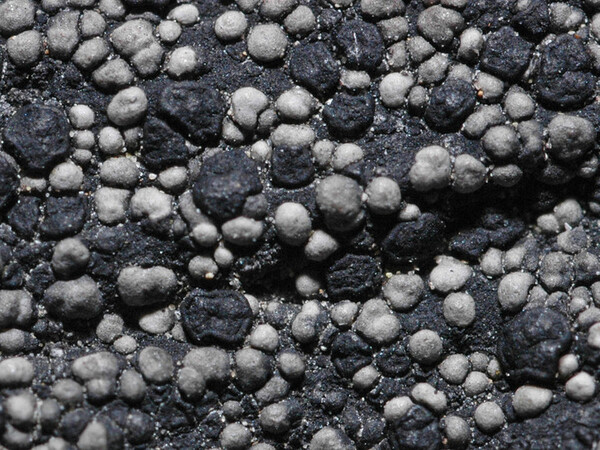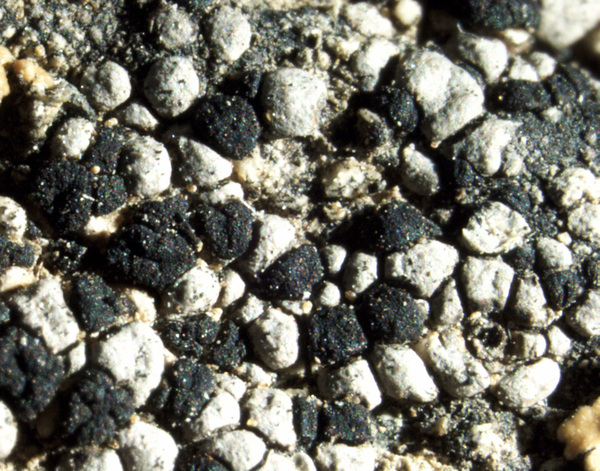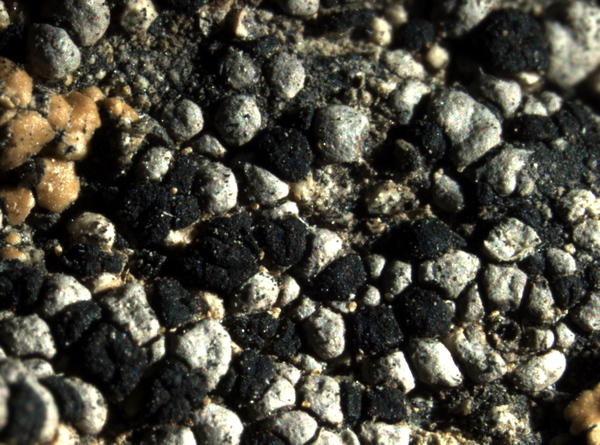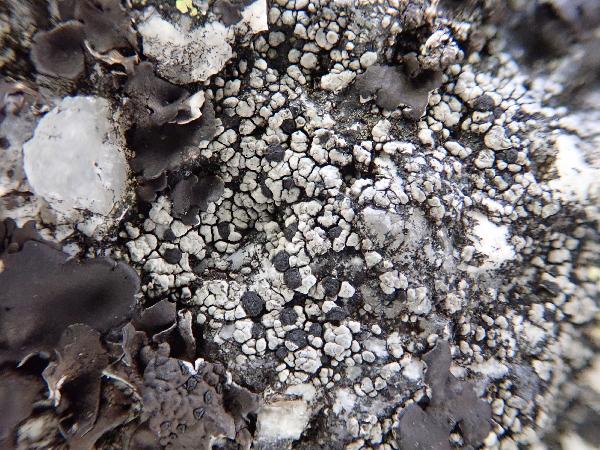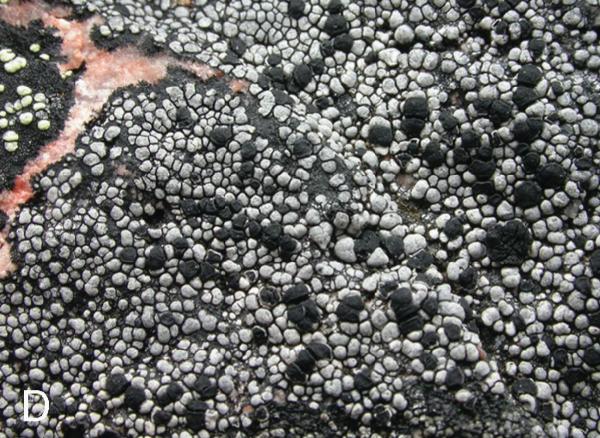Rhizocarpon eupetraeum (Nyl.) Arnold
Flora, 53: 478, 1870. Basionym: Lecidea eupetraea Nyl. - Flora, 53: 36, 1870.
Synonyms: Lecidea parapetraea Nyl.; Lecidea petraeiza Nyl.; Rhizocarpon arcticum Räsänen; Rhizocarpon dissentiens Arnold; Rhizocarpon endamyleum Th. Fr.; Rhizocarpon grande f. eupetraeum (Nyl.) Th. Fr.; Rhizocarpon petraeizum (Nyl.) Kieff.
Description: Thallus crustose, episubstratic, whitish grey, grey to rarely pale brown, dull, areolate, forming 2-6 cm wide patches delimited by a dark prothallus, the areoles contiguous, 0.3-1(-1.4) mm wide, 0.4-0.8 mm thick, strongly convex, smooth. Medulla white, I+ faintly blue. Apothecia lecideine, black, 0.3-1(-1.3) mm across, with a soon convex disc and a thin, soon excluded proper margin. Epithecium brown to brown-black, K+ strongly purple-red, rarely K-; hymenium colourless, 100-140(-160) µm high; paraphysoids coherent, branched and anastomosing; hypothecium brown, K-. Asci 8-spored, clavate, fissitunicate, with a well-developed tholus that is K/I- in lower part and K/I+ blue near the apex, lacking an ocular chamber, Rhizocarpon-type. Ascospores muriform, many-celled, dark brown to brown-black, 19-40 x 10-18 µm. Pycnidia black, subglobose, developing on the prothallus or immersed in the areoles. Conidia hyaline, filiform, 8-14 x 0.5-1.4 µm. Photobiont chlorococcoid. Spot tests: medulla K+ yellow turning red (needle-like crystals), C-, KC-, P+ pale yellow. Chemistry: medulla with norstictic acid.
Growth form: Crustose
Substrata: rocks
Photobiont: green algae other than Trentepohlia
Reproductive strategy: mainly sexual
Commonnes-rarity: (info)
Alpine belt: rare
Subalpine belt: very rare
Montane belt: extremely rare
Dry submediterranean belt: extremely rare
Humid submediterranean belt: absent
Padanian area: absent
pH of the substrata:
1 2 3 4 5
Solar irradiation:
1 2 3 4 5
Aridity:
1 2 3 4 5
Eutrophication:
1 2 3 4 5
Poleotolerance:
0 1 2 3
Altitudinal distribution:
1 2 3 4 5 6
Rarity
absent
extremely rare
very rare
rare
rather rare
rather common
common
very common
extremely common
Loading data...
Occurrence data
Predictive map
Growth form: Crustose
Substrata: rocks
Photobiont: green algae other than Trentepohlia
Reproductive strategy: mainly sexual
Commonnes-rarity: (info)
Alpine belt: rare
Subalpine belt: very rare
Montane belt: extremely rare
Dry submediterranean belt: extremely rare
Humid submediterranean belt: absent
Padanian area: absent
pH of the substrata:
| 1 | 2 | 3 | 4 | 5 |
Solar irradiation:
| 1 | 2 | 3 | 4 | 5 |
Aridity:
| 1 | 2 | 3 | 4 | 5 |
Eutrophication:
| 1 | 2 | 3 | 4 | 5 |
Poleotolerance:
| 0 | 1 | 2 | 3 |
Altitudinal distribution:
| 1 | 2 | 3 | 4 | 5 | 6 |
Rarity
absent
extremely rare
very rare
rare
rather rare
rather common
common
very common
extremely common
Loading data...
Occurrence data
Predictive map


